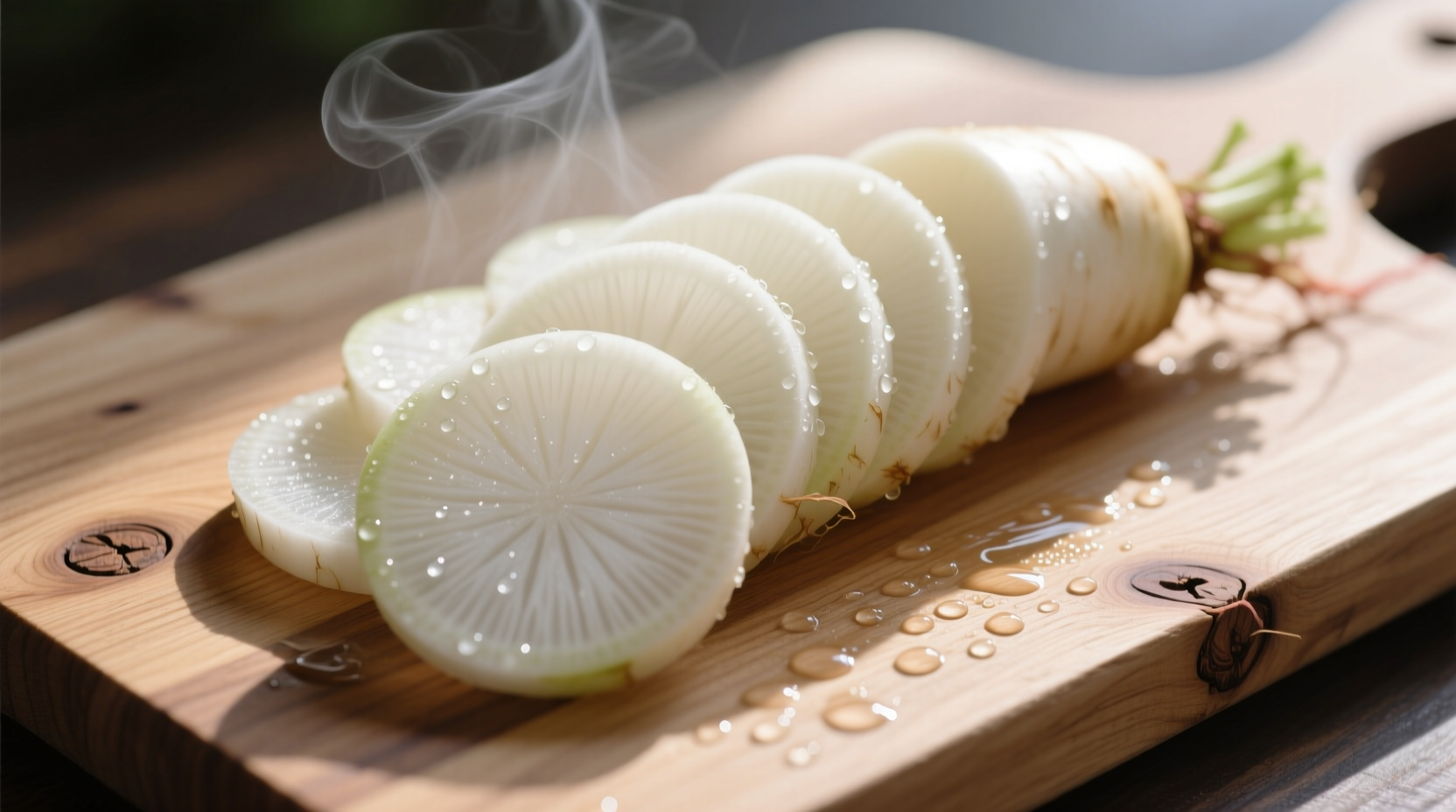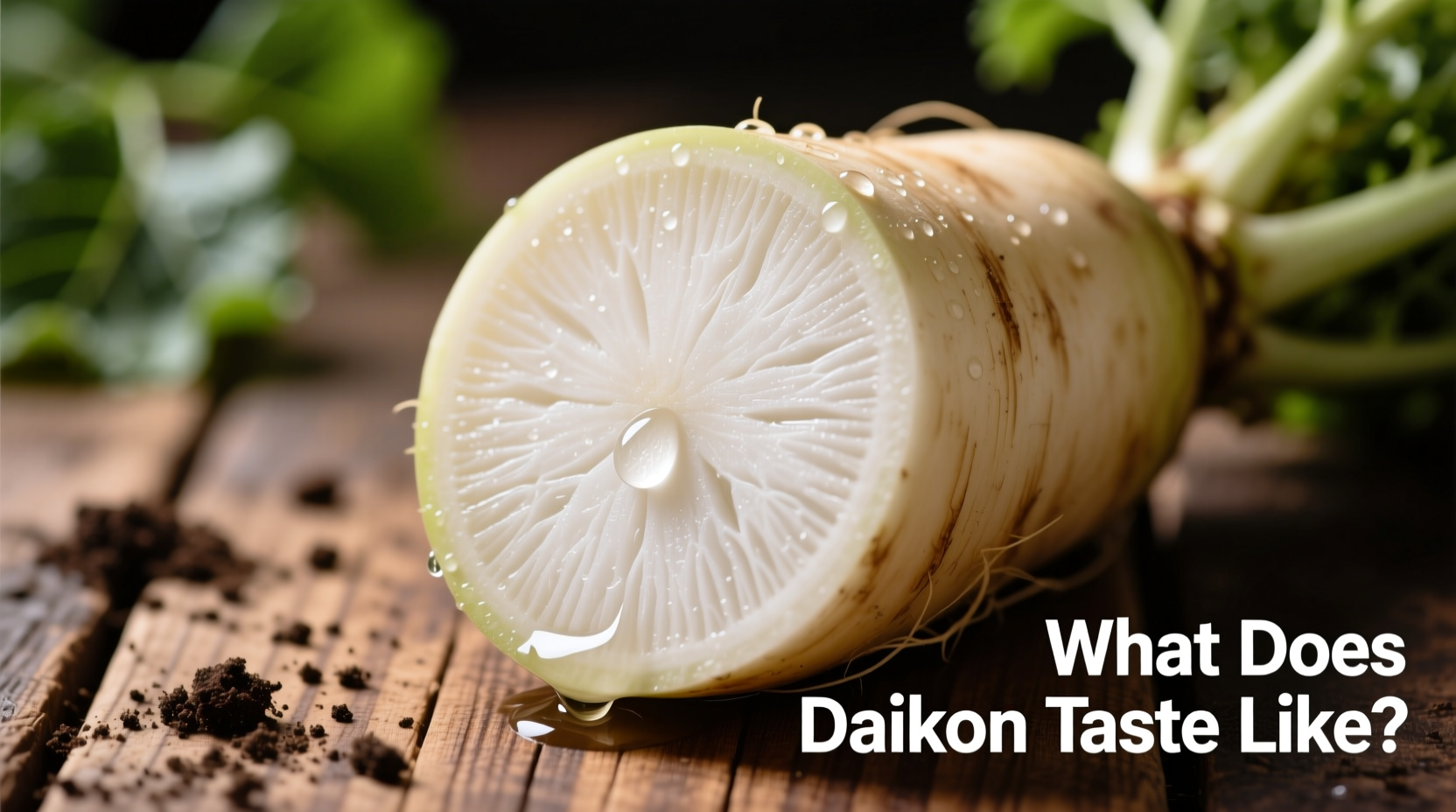Curious about incorporating this versatile Asian vegetable into your cooking but unsure what to expect from its flavor? Understanding daikon's unique taste profile helps you make the most of this nutrient-rich root vegetable in your kitchen. Whether you're encountering daikon for the first time at an Asian market or considering growing it in your garden, knowing exactly how it tastes—both raw and cooked—will transform how you use it in everyday meals.
Decoding Daikon's Flavor Profile: More Than Just a Mild Radish
When you bite into a raw daikon radish, you'll experience a refreshing crispness with a delicate flavor that's significantly milder than the familiar red radish. The initial taste offers subtle sweetness followed by a gentle peppery note that fades quickly without the intense bite common radishes deliver. This complex flavor evolution makes daikon exceptionally versatile in culinary applications.
Unlike its spicy cousins, daikon's heat level registers around 10-20 on the Scoville scale—comparable to a very mild bell pepper rather than a traditional radish. The water content (approximately 95%) contributes to its refreshing quality, while natural sugars develop more prominently as the vegetable matures. Chefs appreciate how daikon's flavor adapts to preparation methods, making it a chameleon in the kitchen.

Raw vs. Cooked: How Preparation Transforms Daikon's Taste
Understanding how cooking affects daikon's flavor is crucial for maximizing its culinary potential. When raw, daikon maintains that signature crisp texture with a clean, slightly peppery finish. But subject it to heat, and a remarkable transformation occurs:
- Steaming or boiling (5-10 minutes): Converts sharp notes into delicate sweetness, similar to cooked turnip
- Stir-frying (2-3 minutes): Preserves slight crunch while mellowing any peppery notes
- Simmering in soups (15+ minutes): Absorbs surrounding flavors while contributing subtle sweetness
- Pickling (24+ hours): Develops tangy complexity while maintaining crisp texture
This dramatic flavor shift explains why daikon appears in both fresh salads and hearty stews across Asian cuisines. Japanese chefs particularly value how prolonged cooking in dishes like otoro daikon (simmered daikon) creates a buttery texture and rich sweetness that complements fatty meats.
Daikon Compared: How It Stacks Up Against Other Root Vegetables
| Vegetable | Raw Flavor Profile | Cooked Flavor Profile | Texture (Raw) |
|---|---|---|---|
| Daikon | Mildly sweet, subtle pepper | Sweet, earthy, buttery | Crisp, juicy |
| Red Radish | Sharp, spicy, peppery | Mildly sweet, slightly bitter | Firm, crisp |
| Turnip | Peppery, slightly bitter | Sweet, earthy, potato-like | Dense, crisp |
| Carrot | Sweet, grassy | Richly sweet, caramelized | Firm, crunchy |
This comparison reveals why daikon serves as such a valuable culinary substitute. Its mild raw flavor makes it more approachable than traditional radishes for salads, while its cooked sweetness bridges the gap between turnips and carrots in soups and stews. The USDA Agricultural Research Service confirms that daikon contains significantly lower levels of glucosinolates—the compounds responsible for radish spiciness—than common red radishes, explaining its milder profile (USDA ARS).
Factors That Influence Daikon's Flavor Development
Several elements affect how daikon tastes, making each harvest potentially different:
Seasonal maturity dramatically impacts flavor. Young daikon harvested in spring has the mildest, sweetest profile with almost no peppery notes. As summer progresses, daikon develops more pronounced flavor complexity but may become slightly woody if left in the ground too long. Fall-harvested daikon often shows the best balance of sweetness and subtle spice.
Growing conditions play a crucial role too. Daikon grown in sandy, well-drained soil develops cleaner flavor than those in heavy clay. Consistent moisture prevents bitterness—irregular watering causes stress that increases pungent compounds. The University of California Cooperative Extension notes that optimal growing temperatures between 50-70°F produce the sweetest daikon with minimal heat (UCCE).
Varietal differences matter significantly. While standard white daikon offers that classic mild profile, specialty varieties like Korean Mu provide earthier notes, and watermelon radish (a daikon variety) delivers vibrant pink flesh with concentrated sweetness. Japanese varieties like Miyashige tend toward exceptional sweetness, while European varieties often show more pronounced peppery notes.
Practical Applications: Using Daikon's Flavor Profile in Your Cooking
Knowing what daikon tastes like translates directly to better cooking decisions. When raw, its mild flavor makes it perfect for:
- Asian slaws and salads where stronger radishes would overpower
- Ceviche and crudo preparations that benefit from subtle spice
- Crudités with dips where traditional radishes might be too spicy
- Quick pickles that maintain delicate flavor balance
When cooked, daikon's flavor transformation shines in:
- Japanese nimono (simmered dishes) where it absorbs dashi beautifully
- Korean kimchi variations that need a milder base vegetable
- Chinese braised dishes where its sweetness complements soy sauces
- Vegetable stocks that benefit from its clean, sweet foundation
Professional chefs recommend peeling daikon only when necessary, as the skin contains concentrated flavor compounds. For raw applications, a quick soak in ice water for 15 minutes further mellows any remaining peppery notes while enhancing crispness—a technique commonly used in high-end Japanese restaurants.
Common Misconceptions About Daikon's Flavor
Several myths persist about daikon's taste that might prevent cooks from using it properly:
"Daikon is just a giant spicy radish"—In reality, daikon contains different compounds than red radishes and is significantly milder. Its heat level is closer to a sweet bell pepper than a traditional radish.
"All daikon tastes the same regardless of preparation"—The flavor transformation from raw to cooked is dramatic, almost like two different vegetables. Understanding this evolution is key to using daikon effectively.
"Daikon always has a bitter aftertaste"—Properly harvested and stored daikon has no bitterness. Bitterness only develops when daikon is over-mature or improperly stored.
Food science research from Tokyo University of Agriculture confirms that daikon's enzymatic changes during cooking convert bitter compounds into sweet ones, explaining why properly cooked daikon tastes completely different from its raw form (Tokyo University of Agriculture).
Selecting and Storing Daikon for Optimal Flavor
Maximizing daikon's delicious potential starts with proper selection:
- Choose firm roots with smooth, unblemished skin—avoid any with soft spots or cracks
- Heavier specimens indicate higher water content and better freshness
- Smaller to medium daikon (6-10 inches) typically offer the best flavor balance
- Check the greens—if attached, they should be vibrant and crisp
For storage, remove leafy tops immediately (they draw moisture from the root) and store daikon in the refrigerator's crisper drawer in a perforated plastic bag. Properly stored, daikon maintains peak flavor for 2-3 weeks. For longer storage, submerge in water in the refrigerator and change the water daily—this method preserves crispness and flavor for up to 4 weeks.
When preparing daikon, use stainless steel knives to prevent discoloration from chemical reactions. Cut just before use to preserve maximum flavor and nutrients—though daikon holds up better than most vegetables when pre-cut.











 浙公网安备
33010002000092号
浙公网安备
33010002000092号 浙B2-20120091-4
浙B2-20120091-4